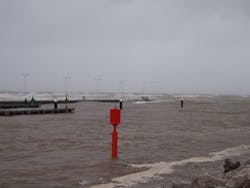Riding the Storm Out
In December 2013, a new harbor wall was put to the test in Rhyl, Wales. The wall was built as part of the Foryd Harbor Enhancement Project, which had the goal of deepening the river channel, enlarging the marina and improving the park area along the river. While the massive December storm caused damage to many other structures in the area, designers were happy to see that the harbor wall performed as engineered.
Challenge
In the spring of 2012, this massive construction project began in Rhyl. To meet the goals of the site and reinforce the harbor’s shoreline, the project first required an aesthetic retaining wall solution that could meet the complex structural challenges of the site, including significant tidal fluctuations.
Solution
Initially, designers considered conventional wall solutions, such as cladded sheet piles, to reinforce the banks and prepare for construction, but that solution was too cost-prohibitive.
Searching for a wall solution that would meet the visual scale and structural requirements, local officials turned to local Redi-Rock manufacturer CPM Group. Designers were able to provide an aesthetic limestone finish with the Redi-Rock Positive Connection (PC) system at a lesser cost than other options.
The Redi-Rock PC system is a mechanically stabilized earth retaining wall system that utilizes 1520-lb precast blocks and a corrosion-free reinforcement system without special connection components. Unlike the friction connections featured in other geosynthetic reinforced wall systems, there is virtually no chance of a pullout connection failure with the PC system because the grid wraps through the block. Because the PC system’s reinforcement is noncorrosive, it is a good fit for projects like this that are exposed to salt water. Although multiple PC system walls have been installed in the U.S., this was the first in the United Kingdom.
At its tallest point, the wall needed to stand 24.3 ft high. It was designed based on the 100-year extreme water level and a 6.6-ft tidal lag.
The Redi-Rock blocks were installed on a concrete foundation in 164-ft sections. When a course of blocks was in place, installers threaded Miragrid 10 XT, 20 XT or 24 XT through the blocks. The layers of backfill material were then placed and the geogrid pulled into position before the next course of blocks was installed.
“The Redi-Rock product is very simple but massively effective,” said Jamie Turner, site agent for Dawnus Construction. “It is easy to install and the end product looks fantastic. I would definitely use this product again.”
To prevent scour, 9.8- to 13.1-ft-long steel sheet piles were installed in front of the Redi-Rock wall. In addition, a reinforced concrete coping was cast in situ, which tied the top course of blocks to the lower course and also created a beam along the wall.
Using the Redi-Rock PC system allowed the contractor to install approximately 50 blocks during a tidal cycle, and installation of the entire harbor wall was completed in just 30 weeks.
Result
A massive storm, near the 100-year level, hit the Rhyl area in December 2013, causing massive tidal surges and waves. Designers were happy to see that all the Redi-Rock walls performed as engineered with only minor aesthetic damage. Based on the performance of this project, the city is now using Redi-Rock for another large shoreline project.


